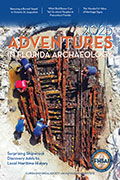GUIDE TO THE BULOW / BUCKNOR PAPERS, 1836 – 1896
MSS 2006
.25 cubic feet
Processed by
Mimi Klug
Jan. 2006
Biography
The Bulow plantation flourished from 1820 when Charles Wilhelm Bulow acquired 6,000 acres, until 1836 when it was destroyed by the fury of the Seminole Indians.
Charles W. Bulow, a wealthy merchant from Charleston, South Carolina established his plantation in Florida, 40 miles south of St. Augustine. He cleared 1500 acres for the production of sugar cane, 1,000 for cotton, and lesser plots for indigo and rice. Over 300 slaves were used to clear the land and erect numerous buildings. In three short years Charles W. Bulow, aged 44, died and his only son, John Joachim, inherited the vast fortune along with his mother and his sister, Emily Ann, later Mrs. William Bucknor of New York City.
The plantation prospered under John J. Bulow and it became synonymous with bounty and wealth. John J. was a dashing young man who had been educated in Paris, France. He built a great sugar mill and a large two story house where he entertained many guests including John James Audubon in 1831. John J. used to travel in state on an eight-oared barge as far as Jupiter Inlet, with his guns, nets, tent and cooks. But the period when young Bulow could live as "monarch of all he surveyed" came to an abrupt end in Dec. 1935 with the outbreak of the Seminole Indian War. Major Benjamin A. Putnam was sent from St. Augustine with a detachment of militia to protect the plantations to the south. Putnam moved his headquarters to Bulow Ville but as he and his column entered the plantation on Dec 28, 1835 they were met with resistance from John J. who fired a four-pounder at the troops. John J. was put under guard in his own home until Jan 23, 1836 when Putnam’s troops and plantation residents retreated to St. Augustine. Shortly thereafter, the Indians burned and destroyed the plantation. John J. Bulow returned to Paris and died the following year at the age of 27. He left no heirs so the estate went to his sister Emily, Mrs. William G. Bucknor of N.Y.
After the seven years of Indian war were over the Bucknor heirs of the Bulow plantation presented a detailed claim to Congress for damages in the amount of $83,475. The bill passed both the House and the Senate but never in the same session, so it finally lapsed.
In 1893, the Bucknor heirs hired John Wedderburn of the Examiner Bureau of Claims to again file a claim against the U. S. and Seminole Indians but it was dismissed in 1906 on the Government’s motion for non-prosecution.
Today, one can visit the ruins at Bulow State Park in Northeast Volusia County near Ormond Beach, Florida.
Scope and Content
An abstract of title originally granted by the Spanish Governor Kindelan, to John Russell in payment for a schooner. In 1821 this land was sold by Mary Russell to Charles W. Bulow. The abstract covers the period from 1812 to 1929.
Extracts of Charles W. Bulow’s will from Charleston, South Carolina in 1824.
A ten page petition to the Senate and House of Representatives by William G. Bucknor for the reparation of the Bulow plantation losses. It includes his itemized list of properties destroyed or stolen and their values. It also includes depositions taken in 1836 and 1837 from, among others, Major Benjamin A. Putnam, Douglas Dummett and Francis Pellicer, overseer of the Plantation.
Two Senate documents, #76 dated 1846 and #253 dated 1851. These are Reports from the Committee of Claims relating to the Bulow claims.
Five letters from John Wedderburn, general manager of Examiner Bureau of Claims written between 1892 and 1893. Wedderburn requested that he represent the Bucknor heirs in a new claim. Sent to the family was Congressional document #139; " An act to provide for the adjudication and payment of claims arising from Indian depradations." Dated 3 March 1891.
Family correspondence. Included in this collection are 18 letters from members of the Bucknor family on personal, family and business matters. 14 of these letters are addressed to William F. (Frank) Bucknor.
George Anderson Grant; adjacent to Bulow’s property. These papers were included with the Bulow papers.
Subject Guide
Bulow, Charles W. and Family
Bucknor, William G. and Family
Putnam, Major Benjamin A.
Dummett, Douglas
Pellicer, Francis
Wedderburn, John
Second Seminole War
Spanish Land Grant – George Anderson Grant
Spanish Land Grant – John Russell
Florida plantations – 19th century
Genealogy – Bulow/Bucknor family
Florida East Coast – history 19th century
Flagler County – history 19th century
Volusia County – history 19th century
Organization
The collection consists of 10 folders. Family correspondence has been put in chronological order.
Provenance
The Bulow/Bucknor papers were donated to the Florida Historical Society in April 1939 by T.E. Fitzgerald.
Restrictions
There are no access restrictions.
FOLDER 1
A collection of Bulow/Bucknor family photos and genealogy chart.
FOLDER 2
Abstract of title covering the period 1812 – 1929.
FOLDER 3
Extracts from the will of Charles W. Bulow, dated 1823 and 1824.
FOLDER 4
Typescripts of depositions taken in 1836 and 1837 regarding the Bulow claim.
List of items that the Seminole Indians took or destroyed in 1836.
Senate document # 76 dated 20 Jan 1846.
Senate document # 253 dated 25 Jan 1851.
FOLDER 5
Family letters 1872 – 1891
FOLDER 6
Family letters 1892 – 1896
FOLDER 7
Letters and a Congressional document from John Wedderburn, general manager of Examiner Bureau of Claims, 1892 – 1893.
FOLDER 8
Miscellaneous material.
FOLDER 9
Printed material. Six published articles about the Bulow plantation.
FOLDER 10
George Anderson Grant. This property was adjacent to Bulow’s and was included in collection.







